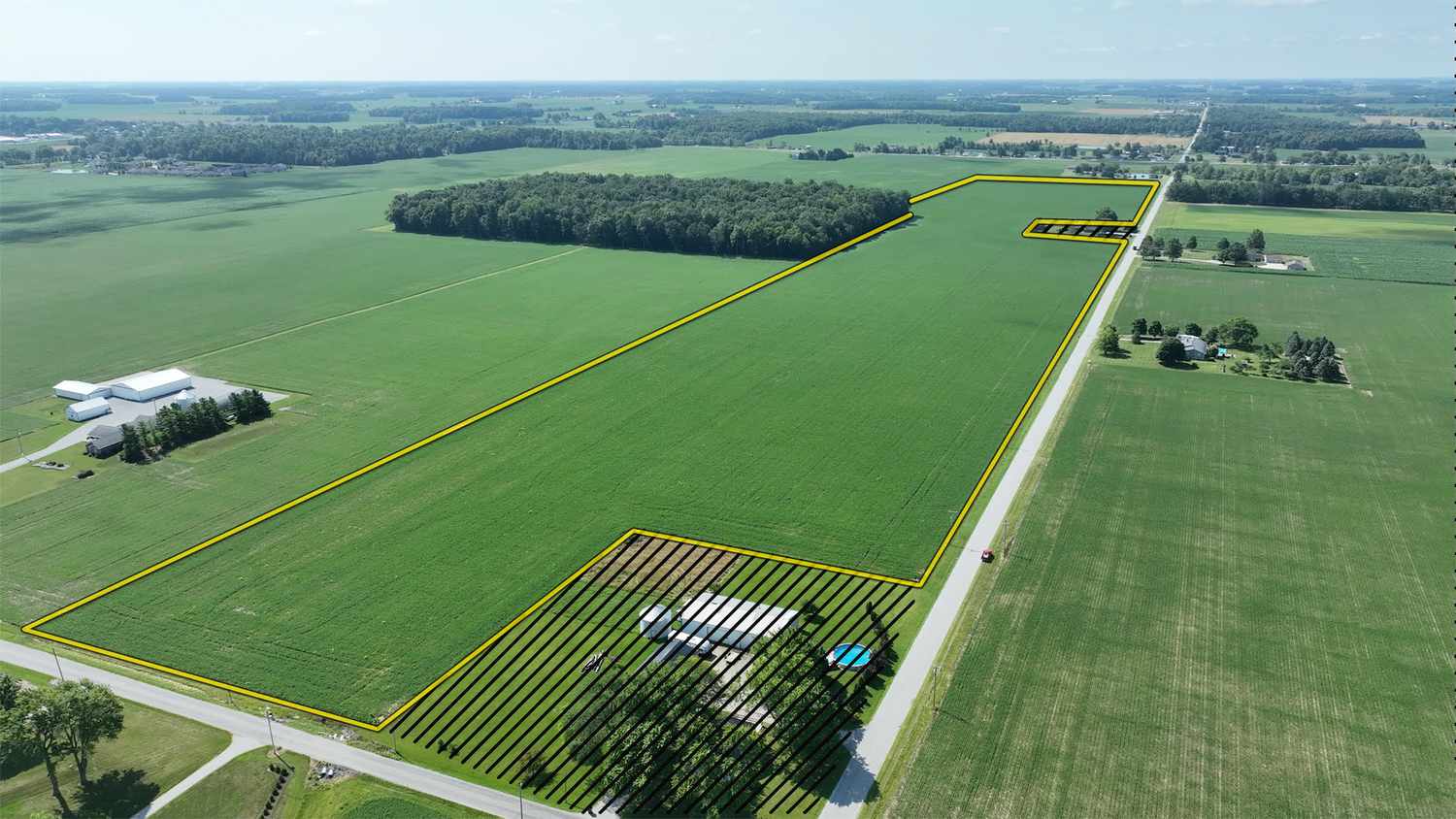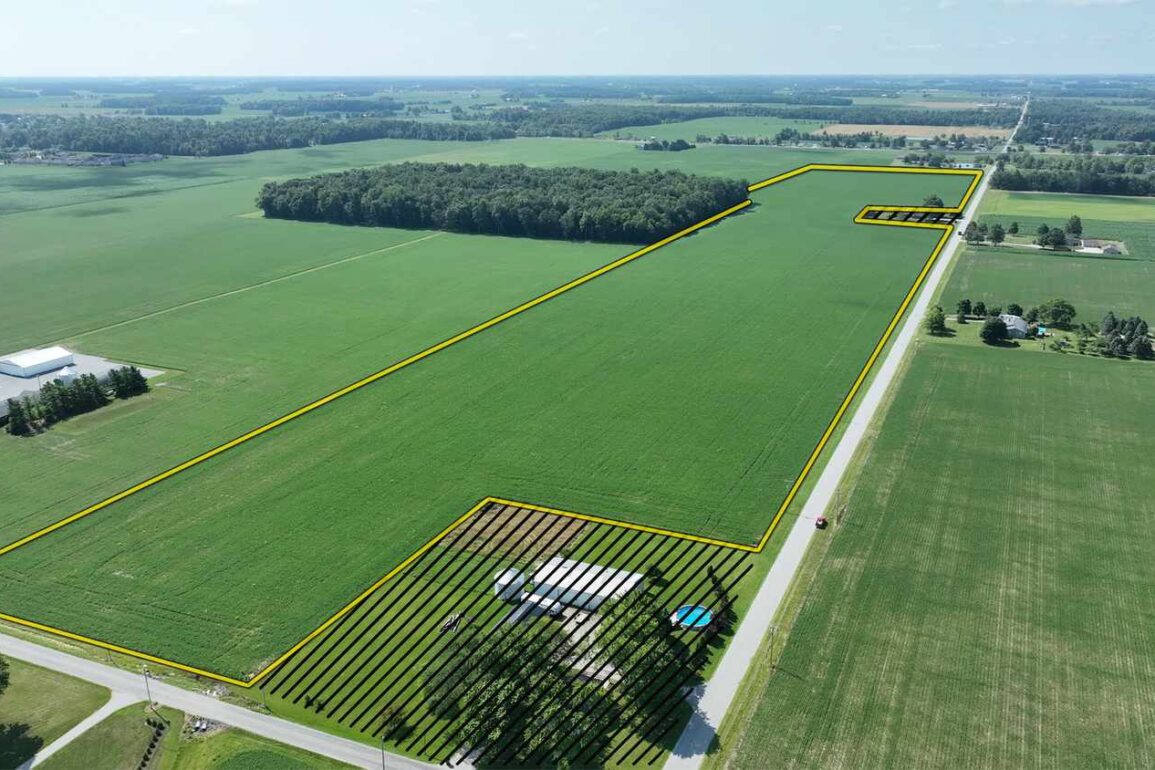
More than 250 people attended the auction of 435 acres in Hoagland and Monroeville, Indiana, on Aug. 22. “It was one of the largest public land auctions in probably 10 years,” says Mike Roy, an agent for Schrader Real Estate and Auction Company who handled the sale.
The land sold was owned by Painter Family Farms, LLC. Most of the land was acquired in the 1970s with a few purchases over the last 10 years, according to Roy. The previous owners, Nancy and Lester Painter, had farmed the land. The couple recently passed away – Lester in 2020 and Nancy in February of this year – and their children who inherited the property decided to sell it.
The sale generated a lot of interest from the community, Roy says, because people wanted to find out who bought it and what the new owners planned to do with the land. “Most farms this size and in this area don’t sell at auction because the land is either passed on to family or sold privately to other farms,” Roy says. He described the area as having lots of deeply rooted families.
Buyers
The land sold for $14,509 to $21,394 an acre. Tract 10 went for the highest amount, according to Roy, because two neighbors who have adjoining land to the property got into a bidding war, driving up the sale price.
The buyers included four farmers, a land developer, and American Electric Power (AEP). Roy believes most of the land will continue to be farmed, besides the tracts purchased by the power company and developer.
The land purchased by AEP sits next to one of its sub stations. The developer bought the 20 acres in Tract 1, which the auction company described as having a considerable amount of road frontage and elevation overlooking the land, making it a “gorgeous” potential building site.
The land
The land sold is in Allen County, about 10 miles southeast of Fort Wayne. It was divided into eight groups and included a total of 14 properties. Thirteen properties were sold at the auction, but one was sold privately before the auction to AEP.
Schrader Real Estate and Auction Company, Inc.
Group 1: Tract 1
These 20 acres of land sold for $360,000 at $18,000 per acre to a developer.
Group 2: tracts 2 and 3
These two properties sold for a total of $615,000 at $17,323 per acre. Both tracts are mostly level with elevation rising toward the south. Tract 2 is 18 acres with a road frontage. The soil is mostly Blount silt loam with some Pewamo silty clay. Tract 3 is 17.5 acres with a frontage along two roads. The soil is a combination of Pewamo silty clay, Blount silt loam, and Glynwood silt loam.
Schrader Real Estate and Auction Company, Inc.
Group 3: tracts 4 through 7
These four properties sold for a total price of $1,741,500 at $14,999 an acre. Tract 4 is 40 acres with 38.6 acres of tillable land, according to an FSA map. Tract 5 is 49.5 acres with a frontage and sits between tracts 4 and 6. Tract 6 is 22 acres with a frontage and borders the open drain to the south. Tracts 4, 5, and 6 are mostly Pewamo silty clay with a mixture of Blount silt loam. Tract 7 is 5 acres with a frontage along two roads. Tract 7 is a mix of Blount silt loam with some Pewamo silty clay.
Schrader Real Estate and Auction Company, Inc.
Group 4: tracts 8 and 9
These two properties are both 12.5 acres and sold for a total of $460,000 at $18,110 an acre. Tract 8 is located at the corner of two roads with frontage along both. Tract 9 has a road frontage and is adjacent to East Allen Schools property adjoining Heritage High School. Both tracts are Pewamo silty clay with a small mix of Blount silt loam.
Schrader Real Estate and Auction Company, Inc.
Group 5: Tract 10
This piece of farmland is 63 acres and sold for $1,350,000 at $21,394 an acre. It includes road frontage with access points on both sides of the adjacent home. The contour is level, and the north property line is the large open ditch dividing tracts 10 and 11. The soil is a mix of Pewamo silty clay and Blount silt loam.
Group 6: Tract 11
This 86-acre property sold for $1,350,000 at $15,535 an acre. This tract has road frontage with access points on both sides of the adjacent property. The contour is level and the south property line is a large open ditch. The soil is mostly Pewamo silty clay with a few small areas of Blount silt loam.
Schrader Real Estate and Auction Company, Inc.
Group 7: tracts 12 and 13
These two properties sold for a total of $740,000 at $14,509 per acre. Tract 12 is 25 acres and includes road frontage and is located west of the original farmstead. The soil is a mix of Pewamo silty clay loam and Haskins loam. The south boundary line is the railroad track. Tract 13 is 26 acres is located east of the original farmstead and also includes road frontage. The soil is mostly Pewamo silty clay loam with a mix of Blount silt loam. The south boundary line is the railroad track.
Group 8: Tract 14
This 38.5-acre property sold for an undisclosed amount prior to the auction to AEP. It sits next to a power substation.
Economic analysis
The sales prices from this auction are higher than the state-wide average for sales this year, according to Purdue University’s Farmland Value and Cash Rent Survey. “Indiana farmland prices have continued the trend of record highs in 2024,” according to the report. “The average price of top-quality farmland reached $14,392 per acre, a 4.8% increase from June 2023. Average and poor-quality farmland also saw gains, with prices increasing 3.7% and 4.4% to $11,630 and $9,071 per acre, respectively.”
Despite these record prices, Todd H. Kuethe, Schrader Endowed Chair in Farmland Economics at Purdue, and the survey’s author, says the farm economy is impacting Indiana land sales. “Most of the traditional drivers of farmland prices are currently placing downward pressure, including interest rates and commodity returns,” he says. “Prices have held steady and grown slightly over the last year as a result of retaining liquidity in the farm sector, robust demand for farmland for development for other uses, and the limited supply of land on the market over the last year.”
Kuethe says the survey he conducted sheds light on what landowners think might happen in the near future and further out. “The respondents of our survey expect land prices to decline by a couple of percentage points in the remainder of 2024. They are a bit more optimistic over the next five years, which taken together suggest prices might moderate slightly in the next year or so, but they do not expect them to deteriorate over the medium term.”
Produced in partnership with American Farmland Owner (AFO). AFO aims to help landowners make informed decisions for their farmland while ensuring the prosperity of American agriculture.
This post was originally published on this site be sure to check out more of their content






